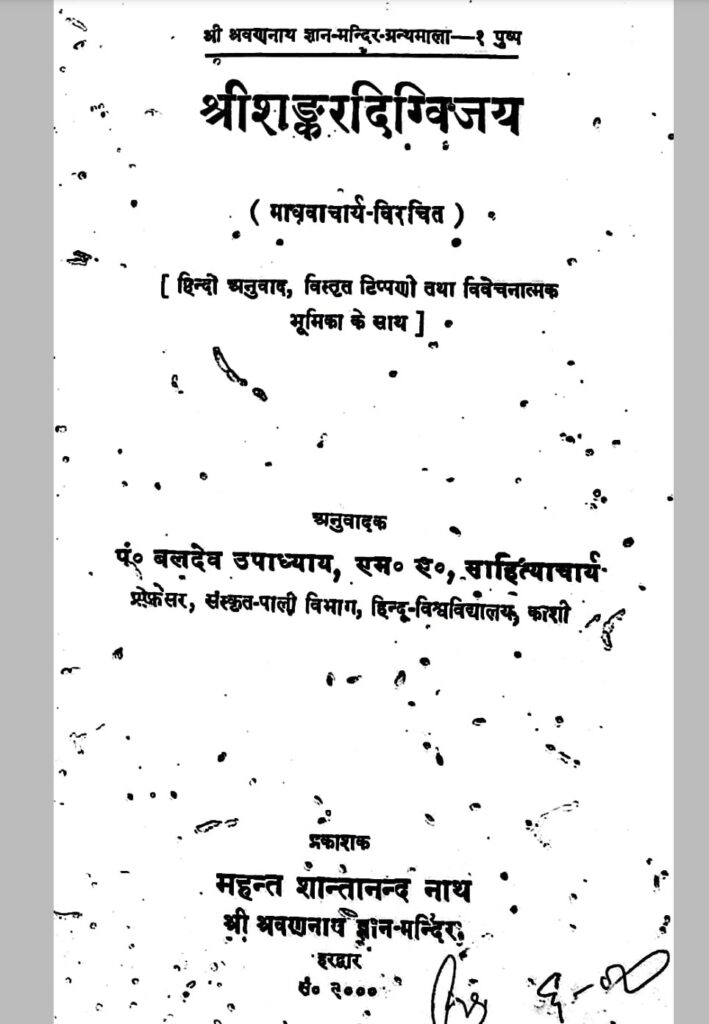
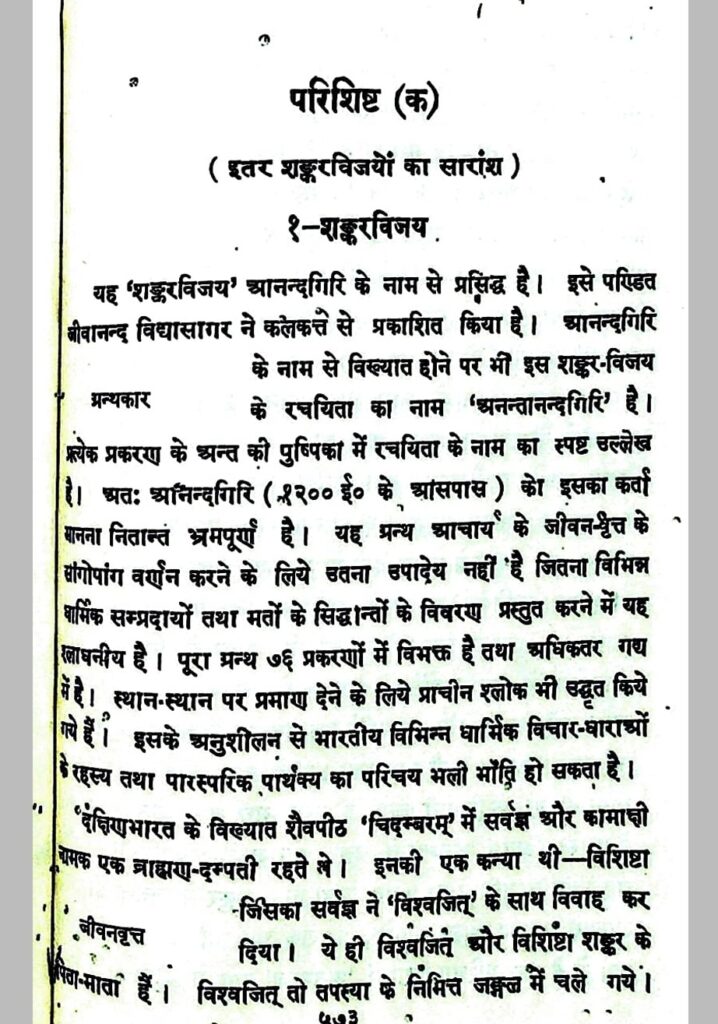
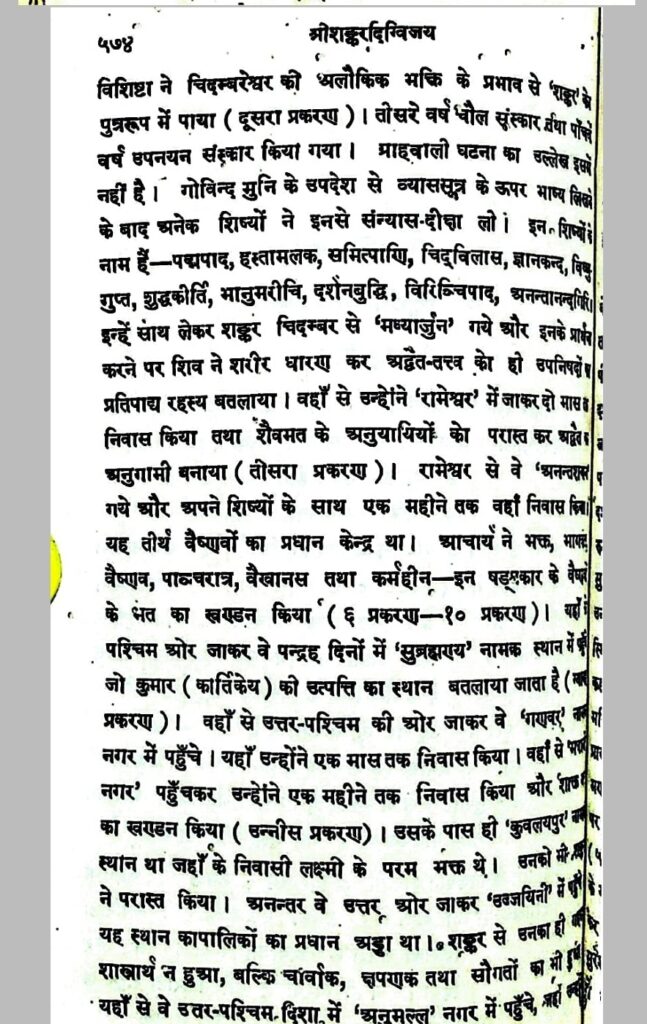

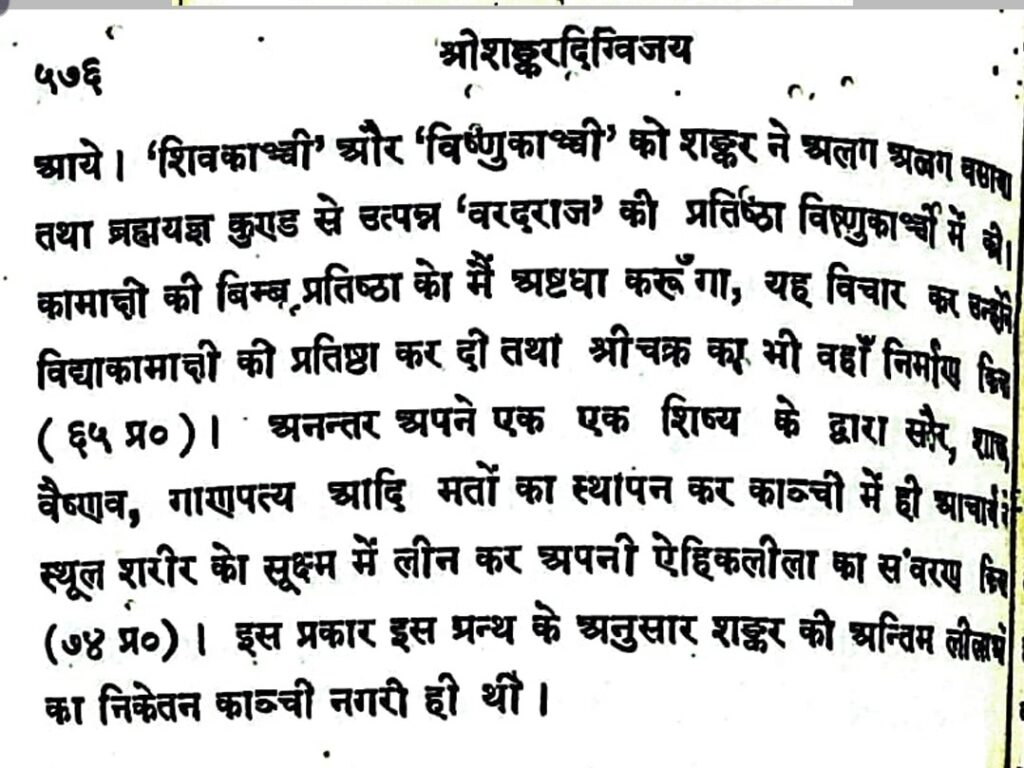





नानाभाष्यादृता सा सगुणफलगतिर्वैधविद्याविशेषै:
तत्तद्देशाप्तिरम्या सरिदिव सकला यत्रयात्यंशभूयम् ।
तस्मिन्नानन्दसिन्धावतिमहति फले भावविश्रान्तिमुद्रा
शास्त्रस्योद्घाटिता यैः प्रणमत हृदि तान्नित्यमाचार्यपादान् ॥
(श्रीमदप्पय्यदीक्षितानां न्यायरक्षामणौ)
“The rivers or the courses of devotion towards the diverse aspects of the Personal God attain their final calm only when they become one with the ocean of bliss (Ananda Sindhu) that unfolds itself at the moment of Ultimate Realization.”
Sri Sankara Bhagavadpada : The Shanmata Sthapanacharya – Shankara And Shanmata
“The celestial wish-yielding tree of Sankara taking its root in the Vedas, and spreading for branches the Shanmatas, gave out to the world at large a rich yield of the fruits of Illumination” thus says Anandagireeya.
“Those who came to scoff remained to pray” said Goldsmith. Those who came as disputants.. the leaders of the various sub-faiths became His disciples.
When Sri Sankara Bhavadpacharya took His abode in Kanchipuram in His last days, He sent out these disciples to propagate the worship of the six divinities within the Vedic framework. They did accordingly and reported back the success of their mission to the Great Acharya.
The 67th and succeeding prakaranas of Anandagiri’s Sankaravijaya, give an account of this. Paramata Kalanala, Lakshmana, Hastamalaka, Divakara, Tripura Kumara and Girijakumara were the disciples who spread the faiths in the different parts of Bharat,
Thus it is clear that Sri Bhagavadpada was Shanmata Sthapaka. He shed off His mortal coils in Kanchi only after the leaders of the six faiths, who were His disciples, reported to Him that the faiths had been stabilised throughout the nation in the new form given by the Achrya which really was their original form.
Iconography
It is significant that Sri Sankaracharya (like Dakshinamurti) is usually represented in sculptures with His four disciples who spread the philosophy of advaita. But, only in Sri Kamakshi Temple (Kamakoshta) and Sri Kanchi Kamakoti Peetam Srimatha (old Puja-griha)- His most important shrines
in Kanchipuram, six disciples are shown in the pedestal/ panel. They are the expounders of the Shanmatas. Two of them are not Sannyasins, their head not covered with cloth. But since they do not have the upavita they could not be brahmacharins or grhastas either. One may conclude they had been tantrics, newly won over to the Smarta tradition.
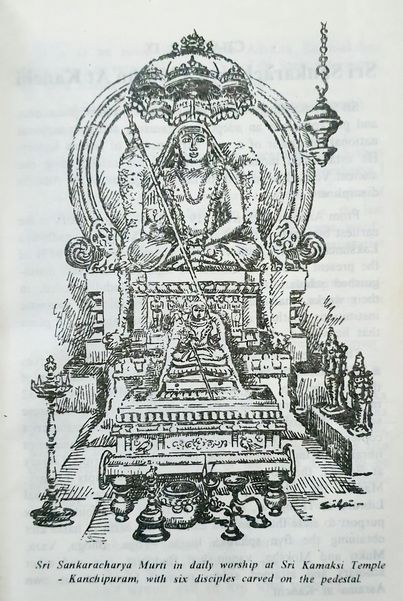
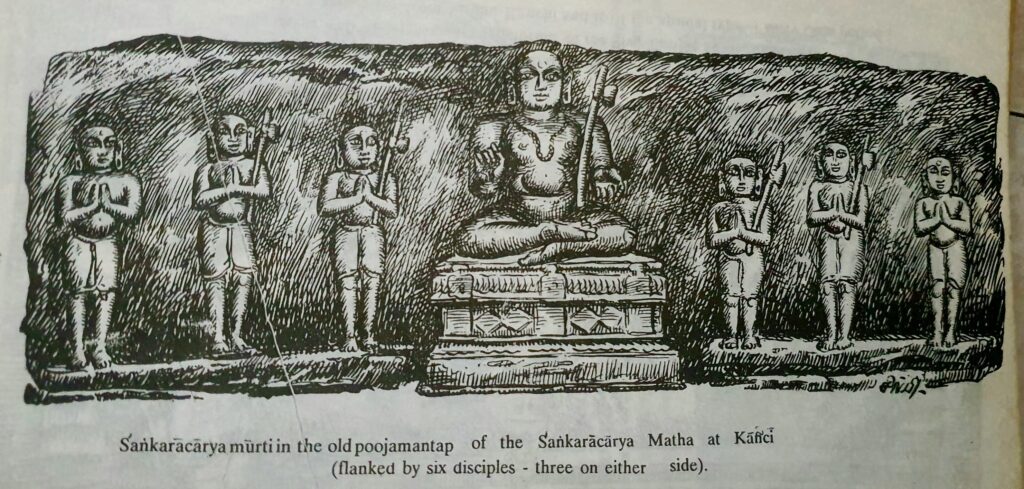
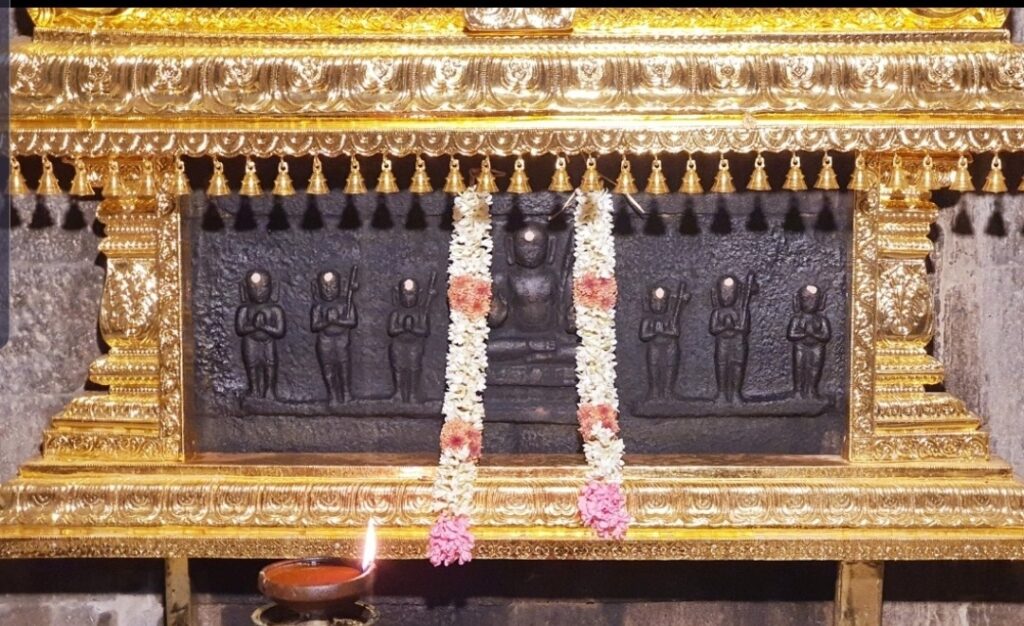
A Note on Tirukkamakkottam
– V.R.Ramachandra Dikshitar [Proceedings of the Indian History Congress (1946)] …2/2
“Tradition avers that Adi Sankara in the course of his digvijaya established mutts at different places and one such place was Kanchi, the modern Conjeevaram.
At Kanchi. Sankara founded what is known as Kamakotipitha. This Pitha of Kamakoti was flourishing here till at least A. D. 1686, and in this connection the temple of Kamakshi in Conjeevaram is said to be the one erected or renovated by Sankara and his disciples.
Even to-day a figure of Sankara is to be seen in this temple, evidently a figure of the first acharya. And Kamakoti is written in inscriptions as Kamakottam.
Kamakottam means the shrine dedicated to the goddess Kamakshi. The cult of Kamakshi must have become popular after Sankara and shrines in her honour were erected and dedicated by kings and pious devotees.
As time went on, the Kamakshi amman koil became generally known as Amman koil. For Parvati or Uma, Minakshi and other names are the names of one and the same goddess. So whatever be the name of the goddess enshrined in a temple, the common people call it even to this day Amman koil.
The revival of Devi worship as Kamakshi must be therefore due to Sankara who founded the Kamakoti pitha in Conjeevaram for the first time. Hence the Kamakottam which we find in the inscriptions. If Kamakottam is the same as Kamakoti, then the institution of Kamakottam must at least go back to the age of Sankara.”
BY V. R. RAMACHANDRA DIKSHITAR, University of Madras. (Part-I)
In a paper contributed to the All India Oriental Conference Nagpur (1946) Mr. K. R. Srinivasan said: ‘In the South Indian temples, Tirukkamakkottam is the name given in inscriptions to the separate shrine dedicated to Parvati or Devi installed and consecrated as the consort of Lord Siva, the presiding deity in a South Indian temple unit’ He further proceeded and remarked that only in the period of the Imperial Cholas the Tirukkamakottam was introduced as a new member and later on grew in importance.
The conclusion arrived at, is based on mere references in the inscriptions, and perhaps also from a study of the temple architecture, and the tentative definition of a temple unit.
According to him till about the eleventh century A. D. there was no place for a separate Amman shrine or shrine for the goddess.
We are afraid that this theory of a separate Amman shrine as a later addition and that from about the eleventh century cannot be readily admitted. This is to ignore all tradition, literary and oral.
We must first examine the term Tirukkamak-kottam or simply Kamakkottam, tiru meaning sacred. The origin of this expression will be indeed significant for our investigation. It may be a very ancient one but it became very much popular certainly after the Adi Sankaracharya. (1/2)
“Since the date (of Sri Sankara Bhagavadpada) arrived at independently from internal evidence agrees, with remarkable exactness, with the date preserved in three of the Mutts, and since the Hultzsch list totally disagrees with the Sringeri list we are led to surmise that there must exist some records within the archives of the Mutt which have not been properly and carefully scrutinised or has seen the light of day. It is hoped that the authorities of the Mutt would afford facilities for real workers with true historical instinct to obtain a peep into them.”
(Extracted from the Article Sri Samkaracharya By Vaidyavisarada K.G.Natesa Sastri, B.A., M.R.A.S. published in Jignasa, Vol.1-4, 1927)

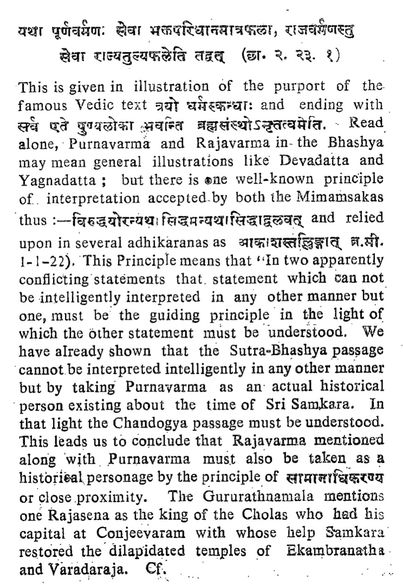
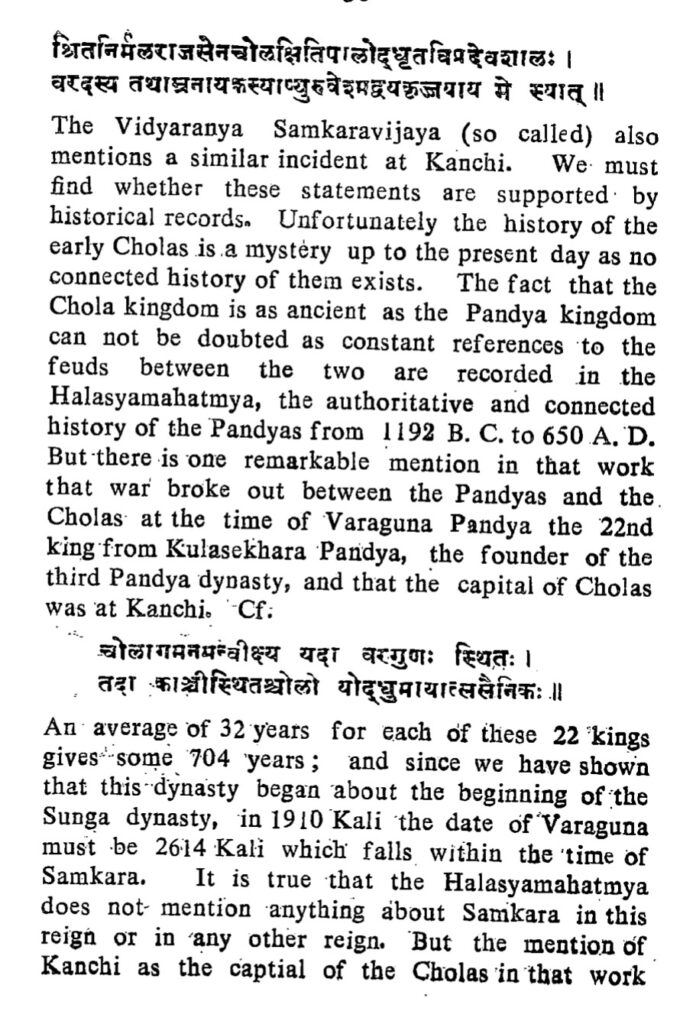
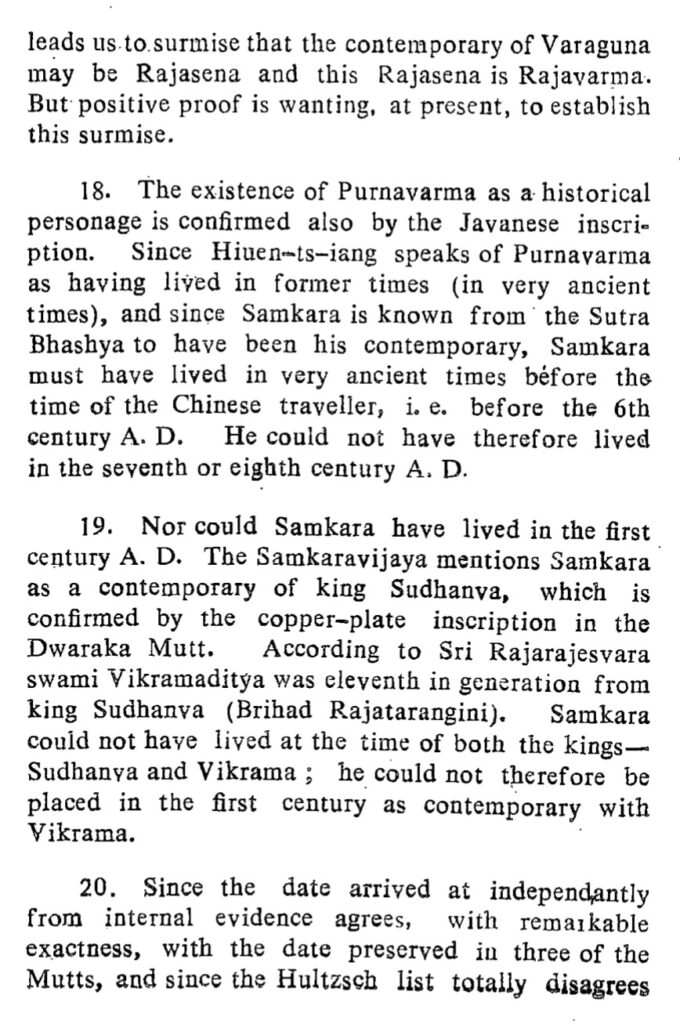
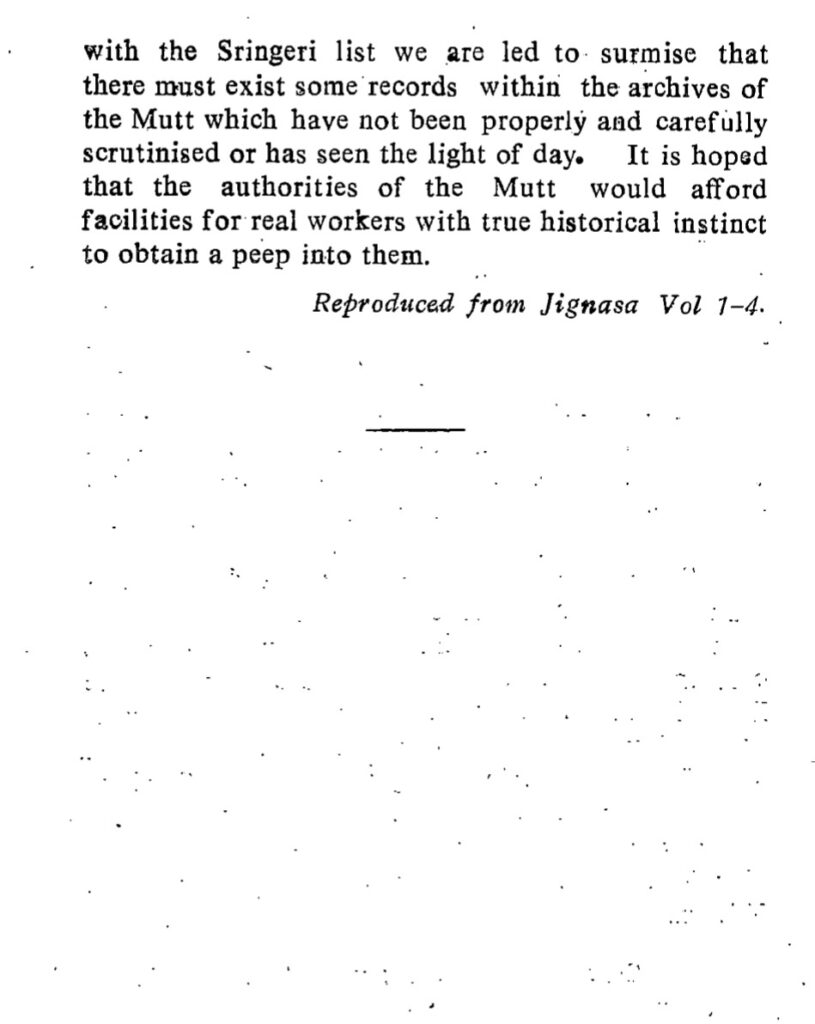
” The extraordinary composure of mind exhibited by his writings forms a striking contrast to those of the other reformers and philosophic writers, and would induce any reader to think that he had nothing to do with Buddhist or any other persecutions as Mr. A. Barth represents when he says that the disciples of Sri Sankaráchárya “Organized into military bands and constituted themselves the rabid (!) defenders of orthodoxy.”
With the exception perhaps of this single writer, every one else firmly believes that he was too philosophical to have hand in those persecutions.
Lastly, towards the end of his life he came to the south, but had to leave his body and this world in Conjeveram, at the early age of thirty-two. We think Conjeveram was the most probable place (of his Nirvana, for at present there is an image of him in the temple of the famous goddess Kámákshi, and judging from the style of architecture and the local traditions to the effect that his body lies buried underneath the image, which is now worshipped.
For Sri Sankaráchárya and his works we have a very high reverence. The loftines calmness, and firmness of his mind, the impartiality with which he deals with the various questions, his clearness of expression – all of these make us revere the philosopher, more and more:.”
– Pandit N.Bhashyacharya,
Adyar Oriental Library
10th October, 1889